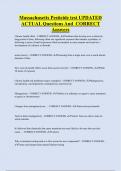Massachusetts Pesticide test UPDATED
ACTUAL Questions And CORRECT
Answers
Chronic health effect - CORRECT ANSWER- ✔✔Problems that develop over a relatively
long period of time, following either one significant exposure that initiates a problem, or
following a series of small exposures which accumulate in some manner and result in a
development of a disease or disorder
acute toxicity - CORRECT ANSWER- ✔✔Poisoning from a single dose over a much shorter
duration of time
How soon do health effects occur from accrue toxicity? - CORRECT ANSWER- ✔✔Within
24 hours of exposure
Chronic health risk problems (major examples) - CORRECT ANSWER- ✔✔Mutagenicity,
oncogenicity, carcinogenicity, teratogenicity, neurotoxicity
Mutagenicity - CORRECT ANSWER- ✔✔Ability of a substance or agent to cause mutations
to genes or chromosomes
Changes from mutagenicity are... - CORRECT ANSWER- ✔✔Almost always harmful
Tests to detect mutagenicity - CORRECT ANSWER- ✔✔Varied. Tests on cells to tests on
whole animals
It's believed that chemicals that cause mutations are more likely to be ones that can also
cause... - CORRECT ANSWER- ✔✔Cancers
Why is mutation testing used as a first screen for new compounds? - CORRECT ANSWER-
✔✔Faster and cheaper than animal lifetime testing
,Oncogenicity - CORRECT ANSWER- ✔✔The ability of a chemical to cause abnormal
growths or tumors in tissues
Carcinogenicity - CORRECT ANSWER- ✔✔Ability of a substance or agent to cause
malignant tumors
How do they test chemicals for their ability to cause tumors - CORRECT ANSWER-
✔✔Administering daily doses to animals for their entire lifetime and then dissecting them to
detect presence of tumors in the animals tissues
A rodent carcinogenicity study takes how long typically? - CORRECT ANSWER- ✔✔2-3
years
Pesticide companies are required to submit test data on oncogenicity from.... - CORRECT
ANSWER- ✔✔Several animal species
There are currently how many pesticide active ingredients considered known, likely, or
probable carcinogens - CORRECT ANSWER- ✔✔Over 70
MDAR - CORRECT ANSWER- ✔✔Massachusetts Department of Agricultural Resources
Act to protect children and families from harmful pesticides - CORRECT ANSWER-
✔✔Passed in 2000. Pesticide products that contain carcinogens may not be used in or around
schools, daycares, or after school programs
Teratogenicity - CORRECT ANSWER- ✔✔Ability of a substance to cause abnormal growth
or deformity in developing fetuses (birth defects)
How is teratogenicity tested - CORRECT ANSWER- ✔✔Administering doses of chemical to
female test animals at various stages of pregnancies and observing number of miscarriages
and defective offspring verses what would normally be expected
Examples of animals used to test teratogenicity - CORRECT ANSWER- ✔✔Rodents,
rabbits, dogs, monkeys
,Effects of chemicals are usually considered significant for teratogenicity if... - CORRECT
ANSWER- ✔✔They occur at doses not toxic by themselves to the mother
Testing for teratogenicity is standard part of pesticide registration although ___________
May exist for older chemicals - CORRECT ANSWER- ✔✔Data gaps
Neurotoxicity - CORRECT ANSWER- ✔✔Gradual damage to basic nerve structure. Does
not refer to reversible effects
Test animal for neurotoxicity - CORRECT ANSWER- ✔✔Chicken
Hepatoxicity - CORRECT ANSWER- ✔✔Damage to liver
Nephrotoxicity - CORRECT ANSWER- ✔✔damage to the kidneys
Immunotoxicity - CORRECT ANSWER- ✔✔Compromise immune system
Fetotoxicity - CORRECT ANSWER- ✔✔Direct toxic injury or death of fetus
Hemotoxic effects - CORRECT ANSWER- ✔✔Blood disorders
Cholinesterases - CORRECT ANSWER- ✔✔Enzymes found in humans, insects, and other
species that are necessary for normal function of the nervous system
What kind of insecticides can block or inhibit cholinesterases - CORRECT ANSWER-
✔✔Organophosphates, carbamates
How much exposure to cholinesterase blocking pesticides does it take to make you feel sick -
CORRECT ANSWER- ✔✔Depends on type of product, potency of active ingredient, amount
of exposure, whether you're handling concentrated or diluted mixture
, Effects of exposure to cholinesterase blocking pesticides - CORRECT ANSWER- ✔✔May
range from no observable effects to severe illnesses or symptoms requiring hospitalization.
Severe poisoning can lead to coma or death
When do symptoms occur after exposure to cholinesterase blocking pesticides - CORRECT
ANSWER- ✔✔Anywhere from time of exposure to 12 hours
Symptoms of acute poisoning from cholinesterase blocking pesticides - CORRECT
ANSWER- ✔✔Nausea, vomiting, diarrhea, tightness in chest, excessive sweating, rapid
heartbeat, cramps, restlessness, headache, confusion
Poisoning from organophosphates or carbamates can resemble... - CORRECT ANSWER-
✔✔Drunkenness, head cold, flu
Why monitor cholinesterase levels - CORRECT ANSWER- ✔✔To establish a baseline for
normal activity and be alerted to any drop in enzyme levels before they reach values low
enough to make you sick. Changes can be detected in absence of symptoms. Workers can be
removed from exposure before symptoms occur
Natural recovery from cholinesterase blocking pesticides exposure normally occurs... -
CORRECT ANSWER- ✔✔When exposure stops
Who should have their cholinesterase levels monitored? - CORRECT ANSWER- ✔✔People
who regularly use organophosphates and carbamates
What should you do if you are inadvertently exposed to cholinesterase blocking pesticides -
CORRECT ANSWER- ✔✔Remove contaminated clothing. Wash area well with soap and
water. Contact physician immediately
How can pesticide exposure effect honey bees - CORRECT ANSWER- ✔✔Disorientation
that can effect how well a bee can navigate, forage for food, and return to colony safely
What are the main contributing factors leading to bee poisoning problems - CORRECT
ANSWER- ✔✔Bloom, toxicity of the pesticide to bees, residual action, formulation, drift of
chemical, timing, temperature, strength of colony, distance from treated fields




